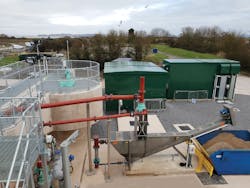In today’s domestic wastewater treatment plant landscape, forced vortex chamber systems are the predominate choice for grit removal. These systems capably protect downstream processes and equipment from abrasion or poor performance from reduced capacity. Forced hydraulic vortex systems, such as the Smith & Loveless Pista grit removal system, are most commonly specified not only for grit removal efficiencies, but also the decades of system development over time, including improvements in baffle technology that offer performance and design flexibility benefits.
Forced hydraulic systems are not settling devices, like virtually all other grit systems. Instead, these chamber designs optimize flow paths and velocities to generate a true forced hydraulic vortex path that effectively removes grit. To accomplish this hydraulic action, the systems combine a specifically inclined inlet flume, a circular chamber with a flat-floor upper chamber and lower collection hopper, an effluent trough and, depending on the design flows, patented integral baffle arrangements.
Recent Smith & Loveless developments in forced vortex chamber technology provide for fine grit removal and the industry standard 95% removal efficiency for grit particles sized down to 105 microns (140 mesh). The driving force, literally, are integral flow control baffles, which ensure the proper velocity and extended flow path around the entire 360 degrees to sweep the entering grit along the chamber flat floor and into a center core opening to the lower collection hopper. The nearby center rotating paddles above the opening serve to lift and separate lighter organic material in the center (enabling it to continue downstream) while the heavier grit particles retreat to the lower hopper. No additional downstream control devices are required to keep the velocity in the preferred range during both peak flow and minimum flow, as the system possesses a 10-to-1 turndown.
Editor's Note: Scranton Gillette Communications and the SGC Water Group is not liable for the accuracy, efficacy and validity of the claims made in this piece. The views expressed in this content do not reflect the position of the editorial teams of Water & Wastes Digest, Water Quality Products and Storm Water Solutions.
